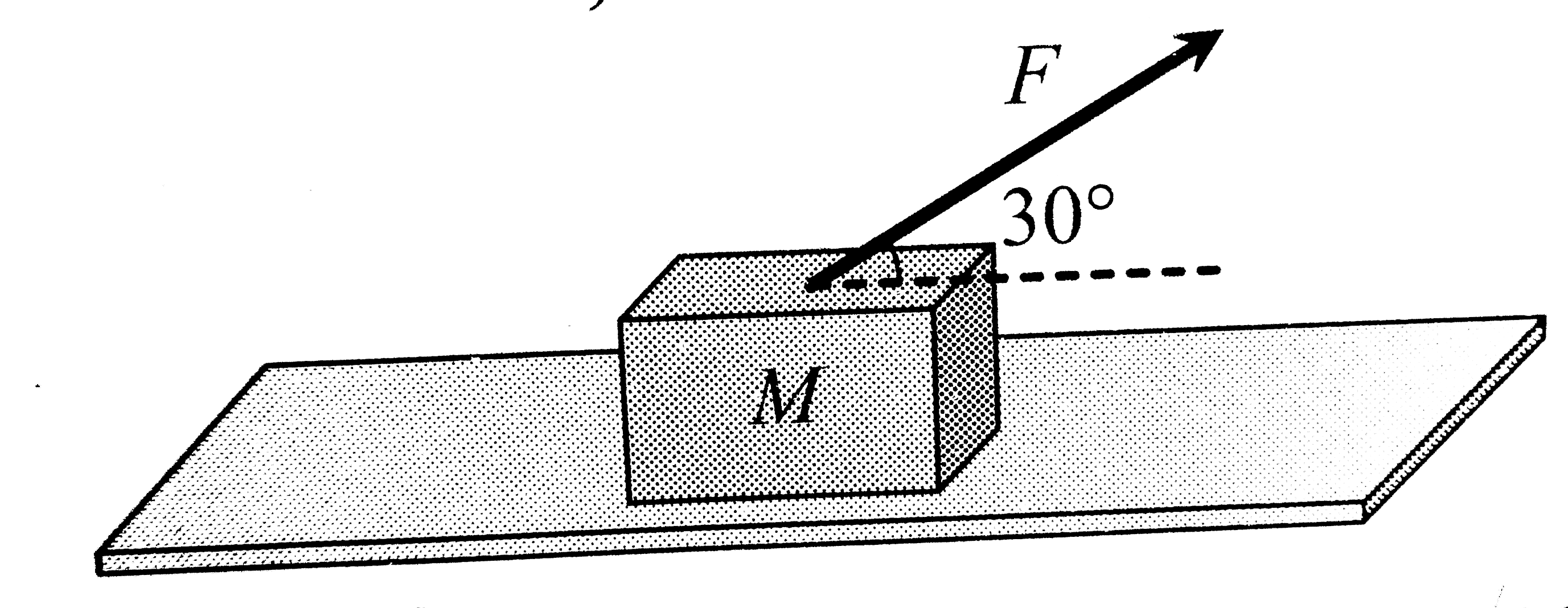A block of mass m=1kg moving on a horizontal surface with speed vi=2ms−1 enters a rough patch ranging from x0.10m→x=2.01m. The retarding force Fr on the block in this range ins inversely proportional to x over this range
Fr=−kxfor0.1<x<2.01m
=0 for <0.1m and x>2.01m where k=0.5J. What is the final K.E. and speed vf of the block as it crosses the patch?
To solve the problem step by step, we will follow the principles of work, energy, and the equations of motion.
Step 1: Understand the forces acting on the block
The block of mass m=1kg is moving with an initial speed vi=2m/s and enters a rough patch where the retarding force Fr is given by:
Fr=−kx
for 0.1<x<2.01m, where k=0.5J. Outside this range, the force is zero.
Step 2: Relate force to acceleration
Using Newton's second law, the force can also be expressed as:
F=m⋅a=m⋅dvdt
We can express acceleration in terms of position x:
F=m⋅v⋅dvdx
Thus, we have:
m⋅v⋅dvdx=−kx
Step 3: Rearranging the equation
Rearranging gives us:
−mkvdv=1xdx
Step 4: Integrate both sides
Integrating both sides from the initial position x=0.1 m to x=2.01 m and from the initial velocity vi=2m/s to the final velocity vf:
∫vfvi−mkvdv=∫2.010.11xdx
Step 5: Calculate the integrals
The left side becomes:
−mk(v22)vfvi=−mk⎛⎝v2f2−v2i2⎞⎠
The right side becomes:
(lnx)2.010.1=ln(2.01)−ln(0.1)=ln(2.010.1)=ln(20.1)
Step 6: Substitute values and solve
Substituting m=1kg and k=0.5J:
−10.5⎛⎝v2f2−(2)22⎞⎠=ln(20.1)
This simplifies to:
−2⎛⎝v2f2−2⎞⎠=ln(20.1)
−(v2f−4)=ln(20.1)
v2f−4=−ln(20.1)
v2f=4−ln(20.1)
Step 7: Calculate vf
Using ln(20.1)≈2.996:
v2f=4−2.996≈1.004
Taking the square root:
vf≈√1.004≈1.002m/s
Step 8: Calculate final kinetic energy
The final kinetic energy KEf is given by:
KEf=12mv2f=12⋅1⋅1.004≈0.502J
Final Answer
- Final Kinetic Energy KEf≈0.502J
- Final Speed vf≈1.002m/s
The block of mass m=1kg is moving with an initial speed vi=2m/s and enters a rough patch where the retarding force Fr is given by:
Fr=−kx
for 0.1<x<2.01m, where k=0.5J. Outside this range, the force is zero.
Using Newton's second law, the force can also be expressed as:
F=m⋅a=m⋅dvdt
We can express acceleration in terms of position x:
F=m⋅v⋅dvdx
Thus, we have:
m⋅v⋅dvdx=−kx
Rearranging gives us:
−mkvdv=1xdx
Integrating both sides from the initial position x=0.1 m to x=2.01 m and from the initial velocity vi=2m/s to the final velocity vf:
∫vfvi−mkvdv=∫2.010.11xdx
The left side becomes:
−mk(v22)vfvi=−mk⎛⎝v2f2−v2i2⎞⎠
The right side becomes:
(lnx)2.010.1=ln(2.01)−ln(0.1)=ln(2.010.1)=ln(20.1)
Substituting m=1kg and k=0.5J:
−10.5⎛⎝v2f2−(2)22⎞⎠=ln(20.1)
This simplifies to:
−2⎛⎝v2f2−2⎞⎠=ln(20.1)
−(v2f−4)=ln(20.1)
v2f−4=−ln(20.1)
v2f=4−ln(20.1)
Using ln(20.1)≈2.996:
v2f=4−2.996≈1.004
Taking the square root:
vf≈√1.004≈1.002m/s
The final kinetic energy KEf is given by:
KEf=12mv2f=12⋅1⋅1.004≈0.502J
- Final Kinetic Energy KEf≈0.502J
- Final Speed vf≈1.002m/s
Topper's Solved these Questions
Similar Questions
A body of mass 2 kg moving on a horizontal surface with a speed vi=1ms−1 enters a rough patch ranging from x=0.5m to x=1.5m. If the body comes to rest after passing the patch, then find the retarding force on the body.
View SolutionA body of mass 2 kg moving on a horiontal surface with speed vi=1ms−1 enters a rough patch ranging from x=0.5m to x=1.5m. If the body comes to rest after passing the patch, then find the retarding force on the body.
View SolutionA block of mass 5kg is lying on a rough horizontal surface. The coefficient of static and kinetic friction are 0.3 and 0.1 and g=10ms−2 The frictional force on the block is
View SolutionA block of mass m=5kg is resting on a rough horizontal surface for which the coefficient of friction is 0.2 . When a force F=40N is applied, the acceleration of the block will be (g=10m/s2) .

View SolutionA block of mass 10 kg, moving in x-direction with a constant speed of 10ms−1, is subjected to a retarding force F=0.1×J/m during its travel from x=20 m to 30 m. Its final KE will be
View SolutionA block of mass 10 kg, moving in x-direction with a constant speed of 10ms−1, is subjected to a retarding force F=0.1×J/m during its travel from x=20 m to 30 m. Its final KE will be
View SolutionA block of mass 0.1 kg attached to a spring of spring constant 400 N/m is putted rightward from x0=0 to x1=15 mm. Find the work done by spring force.
View SolutionA block of mass 20 kg is moving in x-direction with a constant speed of 10 ms−1. It is subjected to a retarding force F=(−0.1x)N during its travel from x=20 m to x=30 m. Its final kinetic energy will be
View SolutionA block of mass 20 kg is moving in x-direction with a constant speed of 10 ms−1. It is subjected to a retarding force F=(−0.1x)N during its travel from x=20 m to x=30 m. Its final kinetic energy will be
View Solutiona block of mass 0.1 kg attached to a spring of spring constant400Nm pulled horizontally from x=0 tox1=10mm. Find the work done by the spring force
View Solution
